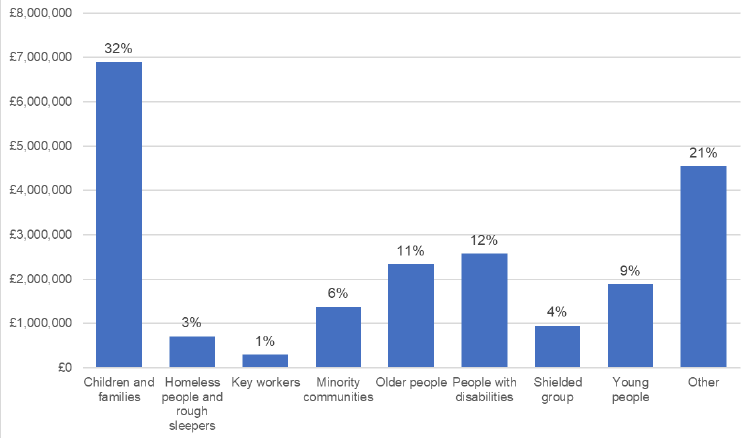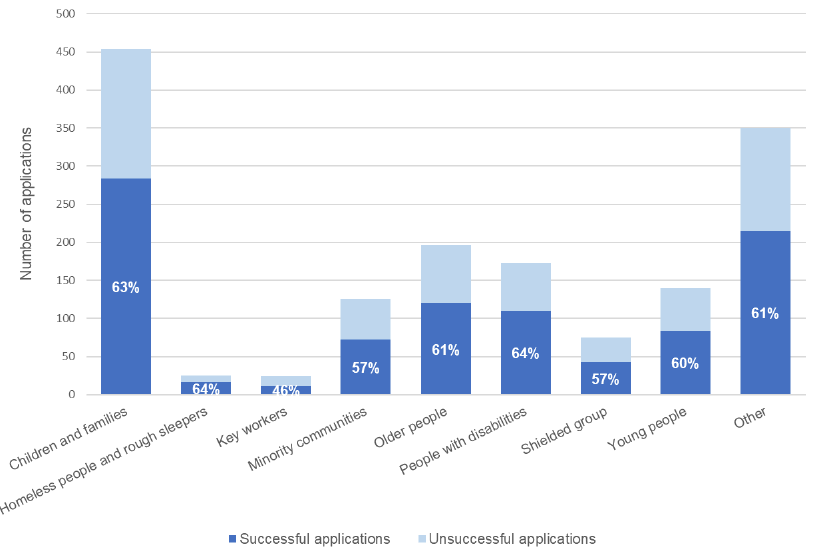Wellbeing Fund: analysis of awards
Analysis of the data on applications and awards made through the Wellbeing Fund Open Application Process and the Small Grants Fund. These funds were part of the Scottish Government’s initial 350 million overall package of funding support to communities, in response to the COVID-19 pandemic
6. Analysis by target beneficiary group
Organisations applying for funding were asked to describe the main target group that their project was intended to support, based on a series of categories. The following table shows the amounts awarded in each category:
| Number of appli-cations | % appli-cations | Number approved | % approved | Amount awarded | % of total value awarded | Average award size | |
|---|---|---|---|---|---|---|---|
| Children and families | 454 | 29% | 284 | 63% | £6,901,870 | 32% | £24,302 |
| People with disabilities | 173 | 13% | 110 | 64% | £2,576,808 | 12% | £23,426 |
| Older people | 196 | 11% | 120 | 61% | £2,341,732 | 11% | £19,514 |
| Young people | 140 | 9% | 84 | 60% | £1,888,736 | 9% | £22,485 |
| Minority communities | 126 | 8% | 72 | 57% | £1,368,844 | 6% | £19,012 |
| Shielded group | 75 | 5% | 43 | 57% | £948,059 | 4% | £22,048 |
| Key workers | 24 | 2% | 11 | 46% | £298,114 | 1% | £27,101 |
| Homeless people and rough sleepers[11] | 14 | 1% | 8 | 57% | £249,292 | 1% | £31,162 |
| Other | 361 | 23% | 223 | 62% | £5,008,878 | 23% | £22,461 |
Children and families was the target group category chosen most frequently by applicants, accounting for 29% of all applications, and 32% of the total amount awarded.
Rates of approval were reasonably similar across the target groups. Projects targeting children and families, older people and people with disabilities had slightly higher rates of approval, while projects targeting key workers had the lowest rates of approval.

In Round One, we identified that applications targeting minority communities had a lower success rate than applications for projects with other target groups. Our analysis suggested that applications targeting minority communities may have come on the whole from smaller organisations which struggled to meet the fund criteria that the project value must not be greater than 20% of the organisation's annual income – and must be greater than £5,000. Based on assessor comments it was likely that at least half of these projects would have been successful if they had claimed within the annual turnover threshold.
Reflecting this, applications from organisations working with minority communities were targeted more actively during the second round of applications, and the fund rules about eligibility were communicated more clearly to all applicants. Round One applicants with strong proposals were encouraged to adapt their proposals and reapply. In Round Two, applications targeting minority communities represented a larger proportion of the total number of applications, and had a much higher success rate than in Round One – 68% compared with 45%.
Twenty-three percent of the total value awarded was to organisations choosing the 'Other' category as the project target group. These projects typically targeted highly vulnerable or at-risk people across multiple target group categories. Applications mentioned mental health, drug or alcohol addiction, victims of abuse, prisoners, asylum seekers, people with long-term chronic health problems, veterans, carers, and people experiencing economic or social hardship as a result of the Covid-19 situation.

Needs identified for different target groups
Applications were asked to describe the target group(s) for their project, and the acute new needs these groups were facing. In practice, there was a lot of overlap in the needs identified for different groups. Throughout the applications there was a strong focus on responding to the impacts of social isolation, meeting basic needs, and technological support.
For shielded groups, older people, and people with disabilities, the most common needs that were identified were:
- Mental health/emotional support to alleviate the burden of social isolation and anxiety;
- Social interaction;
- Practical support for accessing groceries, medications and other essentials;
- Financial support for affording essentials such as food, toiletries and utilities;
- Technological support – help affording and/or accessing/using IT equipment such as phones, tablets or laptops and internet access;
- Physical health and exercise support, particularly for those currently missing out on their usual face-to-face appointments with medical professionals and/or exercise sessions to support their health needs.
All five of these areas of need were also commonly identified for the other target groups.
Specific needs identified for Children and Families and Young People included:
- Educational support in the absence of school (including online resources and access to equipment);
- Domestic violence support and homelessness support;
- Confidence-building, employment support, help applying for benefits, and skills and qualifications training and workshops.
Specific needs identified for Minority Communities included:
- Support overcoming barriers to accessing services;
- Provision of culturally- and religiously-sensitive basic essentials to those in need;
- Financial support for those with no recourse to public funds (e.g. asylum seekers).
Specific needs identified for Key Workers included:
- Access to safe transport for those without private cars;
- Resilience training and support to help cope with the personal and professional pressures they are currently facing.
Contact
Email: socialresearch@gov.scot
There is a problem
Thanks for your feedback